The Syrian Civil War: A Descriptive and Normative Analysis
VerifiedAdded on 2022/10/07
|11
|3258
|29
Essay
AI Summary
This essay provides a comprehensive analysis of the Syrian Civil War, examining its origins in the Arab Spring and the subsequent involvement of numerous international actors. It explores the socio-economic factors that fueled the conflict, including the policies of Bashar al-Assad's regime and rising socio-economic inequalities. The essay details the involvement of countries like Russia, the United States, and others, and evaluates the conflict through the lens of just war theory, analyzing both *jus ad bellum* and *jus in bello* considerations. It highlights the complexities of the conflict, including intergroup conflicts, human rights violations, and the challenges of achieving a resolution. The essay concludes by reflecting on the ethical dimensions of the war and the ongoing impact on the Syrian people.
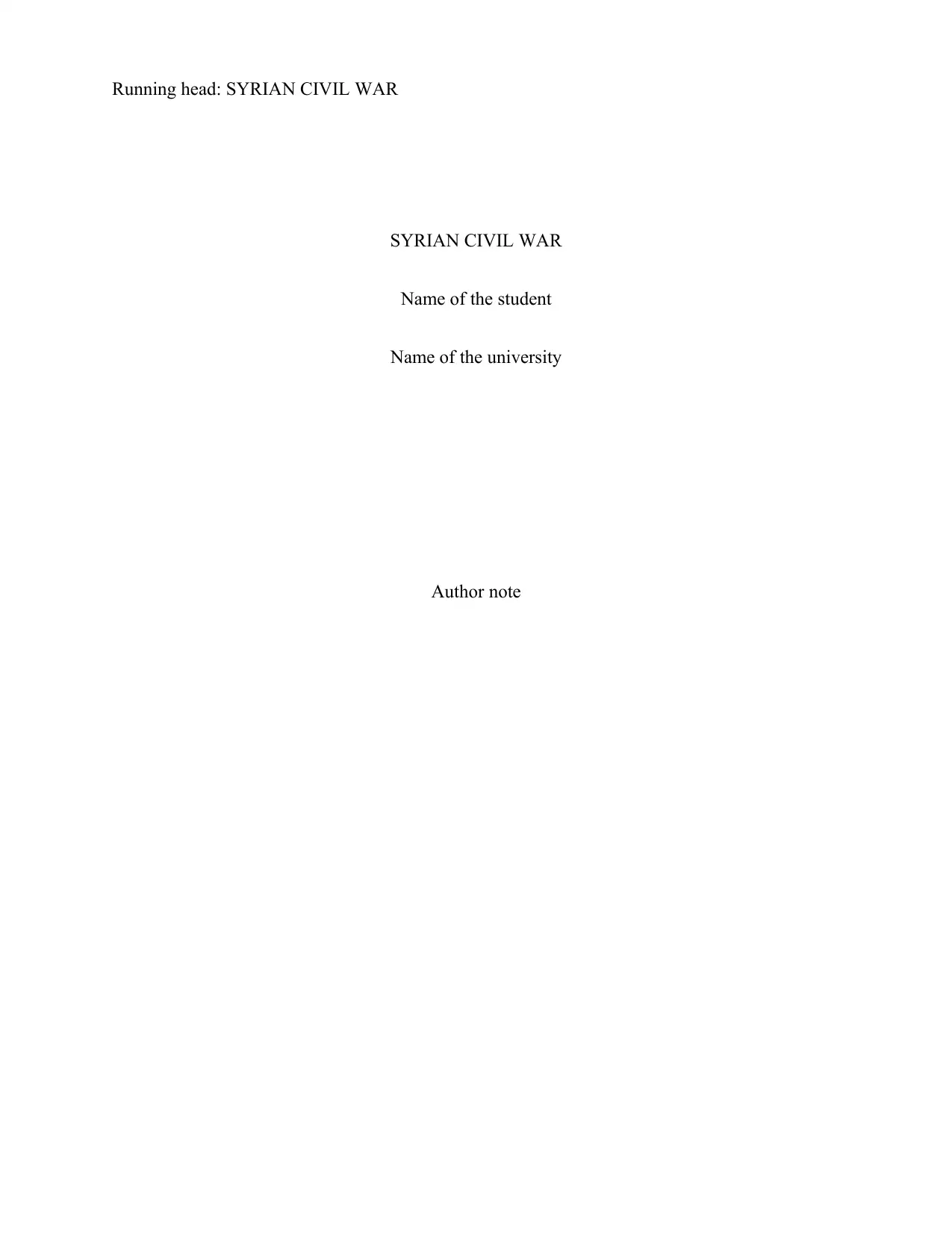
Running head: SYRIAN CIVIL WAR
SYRIAN CIVIL WAR
Name of the student
Name of the university
Author note
SYRIAN CIVIL WAR
Name of the student
Name of the university
Author note
Paraphrase This Document
Need a fresh take? Get an instant paraphrase of this document with our AI Paraphraser
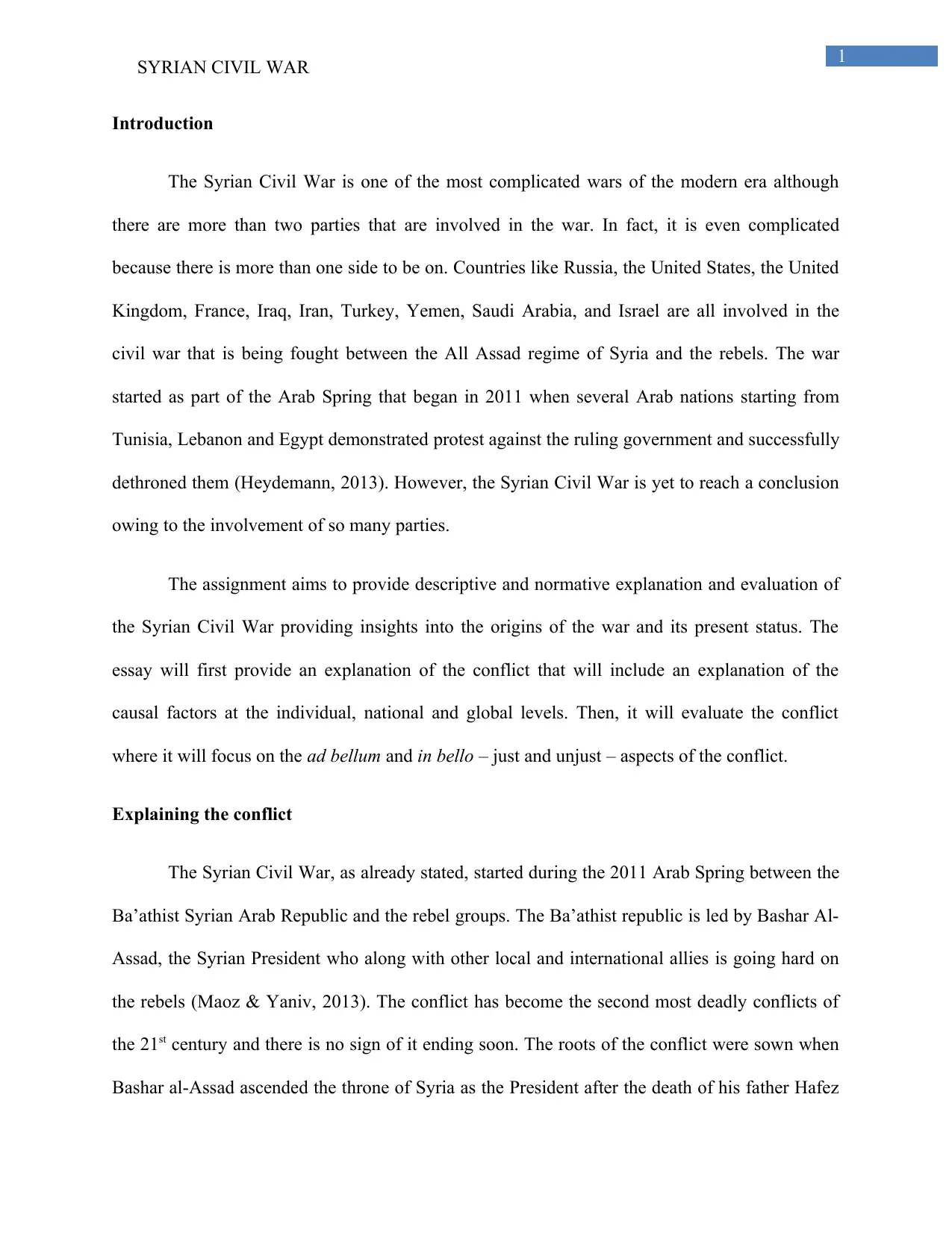
1
SYRIAN CIVIL WAR
Introduction
The Syrian Civil War is one of the most complicated wars of the modern era although
there are more than two parties that are involved in the war. In fact, it is even complicated
because there is more than one side to be on. Countries like Russia, the United States, the United
Kingdom, France, Iraq, Iran, Turkey, Yemen, Saudi Arabia, and Israel are all involved in the
civil war that is being fought between the All Assad regime of Syria and the rebels. The war
started as part of the Arab Spring that began in 2011 when several Arab nations starting from
Tunisia, Lebanon and Egypt demonstrated protest against the ruling government and successfully
dethroned them (Heydemann, 2013). However, the Syrian Civil War is yet to reach a conclusion
owing to the involvement of so many parties.
The assignment aims to provide descriptive and normative explanation and evaluation of
the Syrian Civil War providing insights into the origins of the war and its present status. The
essay will first provide an explanation of the conflict that will include an explanation of the
causal factors at the individual, national and global levels. Then, it will evaluate the conflict
where it will focus on the ad bellum and in bello – just and unjust – aspects of the conflict.
Explaining the conflict
The Syrian Civil War, as already stated, started during the 2011 Arab Spring between the
Ba’athist Syrian Arab Republic and the rebel groups. The Ba’athist republic is led by Bashar Al-
Assad, the Syrian President who along with other local and international allies is going hard on
the rebels (Maoz & Yaniv, 2013). The conflict has become the second most deadly conflicts of
the 21st century and there is no sign of it ending soon. The roots of the conflict were sown when
Bashar al-Assad ascended the throne of Syria as the President after the death of his father Hafez
SYRIAN CIVIL WAR
Introduction
The Syrian Civil War is one of the most complicated wars of the modern era although
there are more than two parties that are involved in the war. In fact, it is even complicated
because there is more than one side to be on. Countries like Russia, the United States, the United
Kingdom, France, Iraq, Iran, Turkey, Yemen, Saudi Arabia, and Israel are all involved in the
civil war that is being fought between the All Assad regime of Syria and the rebels. The war
started as part of the Arab Spring that began in 2011 when several Arab nations starting from
Tunisia, Lebanon and Egypt demonstrated protest against the ruling government and successfully
dethroned them (Heydemann, 2013). However, the Syrian Civil War is yet to reach a conclusion
owing to the involvement of so many parties.
The assignment aims to provide descriptive and normative explanation and evaluation of
the Syrian Civil War providing insights into the origins of the war and its present status. The
essay will first provide an explanation of the conflict that will include an explanation of the
causal factors at the individual, national and global levels. Then, it will evaluate the conflict
where it will focus on the ad bellum and in bello – just and unjust – aspects of the conflict.
Explaining the conflict
The Syrian Civil War, as already stated, started during the 2011 Arab Spring between the
Ba’athist Syrian Arab Republic and the rebel groups. The Ba’athist republic is led by Bashar Al-
Assad, the Syrian President who along with other local and international allies is going hard on
the rebels (Maoz & Yaniv, 2013). The conflict has become the second most deadly conflicts of
the 21st century and there is no sign of it ending soon. The roots of the conflict were sown when
Bashar al-Assad ascended the throne of Syria as the President after the death of his father Hafez
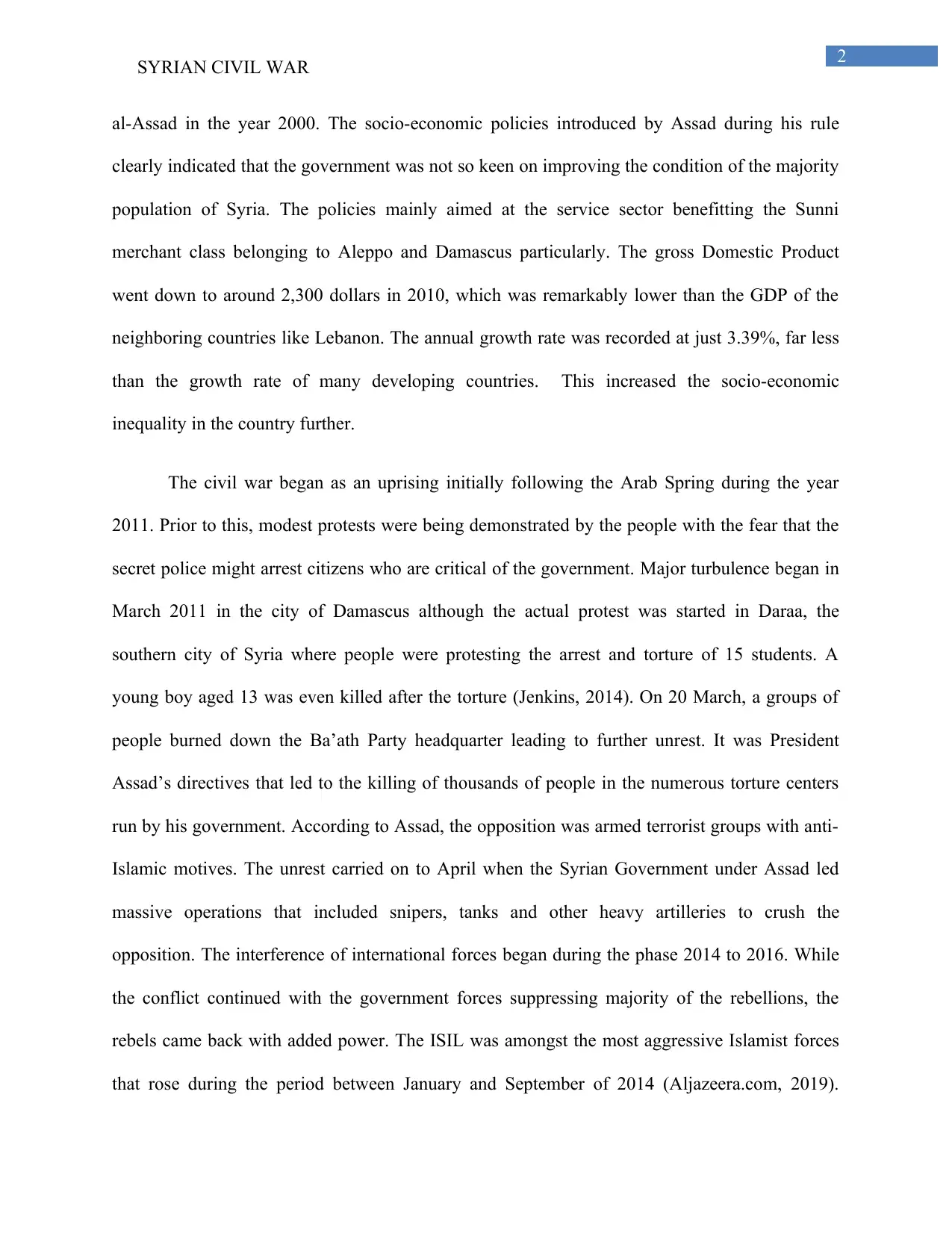
2
SYRIAN CIVIL WAR
al-Assad in the year 2000. The socio-economic policies introduced by Assad during his rule
clearly indicated that the government was not so keen on improving the condition of the majority
population of Syria. The policies mainly aimed at the service sector benefitting the Sunni
merchant class belonging to Aleppo and Damascus particularly. The gross Domestic Product
went down to around 2,300 dollars in 2010, which was remarkably lower than the GDP of the
neighboring countries like Lebanon. The annual growth rate was recorded at just 3.39%, far less
than the growth rate of many developing countries. This increased the socio-economic
inequality in the country further.
The civil war began as an uprising initially following the Arab Spring during the year
2011. Prior to this, modest protests were being demonstrated by the people with the fear that the
secret police might arrest citizens who are critical of the government. Major turbulence began in
March 2011 in the city of Damascus although the actual protest was started in Daraa, the
southern city of Syria where people were protesting the arrest and torture of 15 students. A
young boy aged 13 was even killed after the torture (Jenkins, 2014). On 20 March, a groups of
people burned down the Ba’ath Party headquarter leading to further unrest. It was President
Assad’s directives that led to the killing of thousands of people in the numerous torture centers
run by his government. According to Assad, the opposition was armed terrorist groups with anti-
Islamic motives. The unrest carried on to April when the Syrian Government under Assad led
massive operations that included snipers, tanks and other heavy artilleries to crush the
opposition. The interference of international forces began during the phase 2014 to 2016. While
the conflict continued with the government forces suppressing majority of the rebellions, the
rebels came back with added power. The ISIL was amongst the most aggressive Islamist forces
that rose during the period between January and September of 2014 (Aljazeera.com, 2019).
SYRIAN CIVIL WAR
al-Assad in the year 2000. The socio-economic policies introduced by Assad during his rule
clearly indicated that the government was not so keen on improving the condition of the majority
population of Syria. The policies mainly aimed at the service sector benefitting the Sunni
merchant class belonging to Aleppo and Damascus particularly. The gross Domestic Product
went down to around 2,300 dollars in 2010, which was remarkably lower than the GDP of the
neighboring countries like Lebanon. The annual growth rate was recorded at just 3.39%, far less
than the growth rate of many developing countries. This increased the socio-economic
inequality in the country further.
The civil war began as an uprising initially following the Arab Spring during the year
2011. Prior to this, modest protests were being demonstrated by the people with the fear that the
secret police might arrest citizens who are critical of the government. Major turbulence began in
March 2011 in the city of Damascus although the actual protest was started in Daraa, the
southern city of Syria where people were protesting the arrest and torture of 15 students. A
young boy aged 13 was even killed after the torture (Jenkins, 2014). On 20 March, a groups of
people burned down the Ba’ath Party headquarter leading to further unrest. It was President
Assad’s directives that led to the killing of thousands of people in the numerous torture centers
run by his government. According to Assad, the opposition was armed terrorist groups with anti-
Islamic motives. The unrest carried on to April when the Syrian Government under Assad led
massive operations that included snipers, tanks and other heavy artilleries to crush the
opposition. The interference of international forces began during the phase 2014 to 2016. While
the conflict continued with the government forces suppressing majority of the rebellions, the
rebels came back with added power. The ISIL was amongst the most aggressive Islamist forces
that rose during the period between January and September of 2014 (Aljazeera.com, 2019).
⊘ This is a preview!⊘
Do you want full access?
Subscribe today to unlock all pages.

Trusted by 1+ million students worldwide
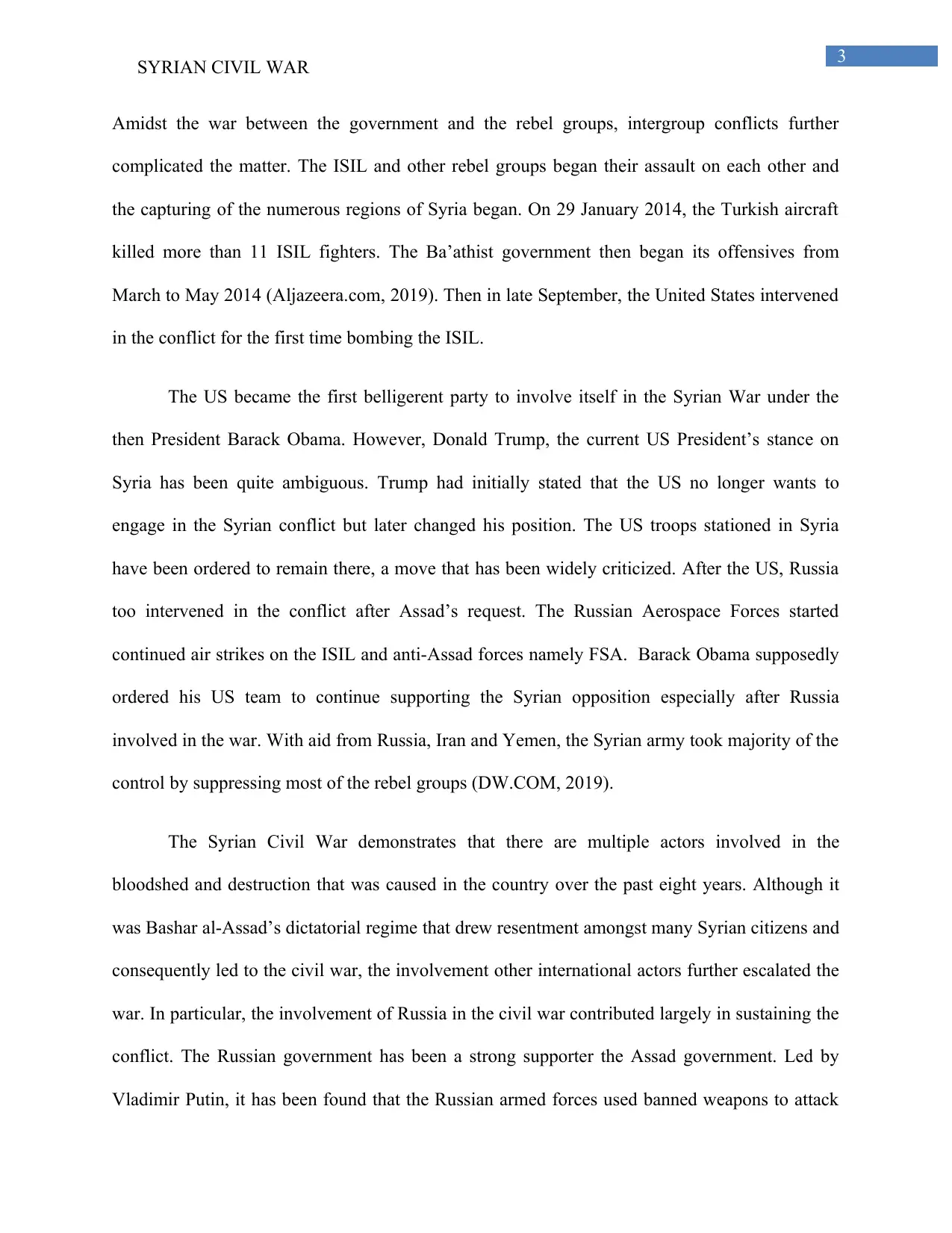
3
SYRIAN CIVIL WAR
Amidst the war between the government and the rebel groups, intergroup conflicts further
complicated the matter. The ISIL and other rebel groups began their assault on each other and
the capturing of the numerous regions of Syria began. On 29 January 2014, the Turkish aircraft
killed more than 11 ISIL fighters. The Ba’athist government then began its offensives from
March to May 2014 (Aljazeera.com, 2019). Then in late September, the United States intervened
in the conflict for the first time bombing the ISIL.
The US became the first belligerent party to involve itself in the Syrian War under the
then President Barack Obama. However, Donald Trump, the current US President’s stance on
Syria has been quite ambiguous. Trump had initially stated that the US no longer wants to
engage in the Syrian conflict but later changed his position. The US troops stationed in Syria
have been ordered to remain there, a move that has been widely criticized. After the US, Russia
too intervened in the conflict after Assad’s request. The Russian Aerospace Forces started
continued air strikes on the ISIL and anti-Assad forces namely FSA. Barack Obama supposedly
ordered his US team to continue supporting the Syrian opposition especially after Russia
involved in the war. With aid from Russia, Iran and Yemen, the Syrian army took majority of the
control by suppressing most of the rebel groups (DW.COM, 2019).
The Syrian Civil War demonstrates that there are multiple actors involved in the
bloodshed and destruction that was caused in the country over the past eight years. Although it
was Bashar al-Assad’s dictatorial regime that drew resentment amongst many Syrian citizens and
consequently led to the civil war, the involvement other international actors further escalated the
war. In particular, the involvement of Russia in the civil war contributed largely in sustaining the
conflict. The Russian government has been a strong supporter the Assad government. Led by
Vladimir Putin, it has been found that the Russian armed forces used banned weapons to attack
SYRIAN CIVIL WAR
Amidst the war between the government and the rebel groups, intergroup conflicts further
complicated the matter. The ISIL and other rebel groups began their assault on each other and
the capturing of the numerous regions of Syria began. On 29 January 2014, the Turkish aircraft
killed more than 11 ISIL fighters. The Ba’athist government then began its offensives from
March to May 2014 (Aljazeera.com, 2019). Then in late September, the United States intervened
in the conflict for the first time bombing the ISIL.
The US became the first belligerent party to involve itself in the Syrian War under the
then President Barack Obama. However, Donald Trump, the current US President’s stance on
Syria has been quite ambiguous. Trump had initially stated that the US no longer wants to
engage in the Syrian conflict but later changed his position. The US troops stationed in Syria
have been ordered to remain there, a move that has been widely criticized. After the US, Russia
too intervened in the conflict after Assad’s request. The Russian Aerospace Forces started
continued air strikes on the ISIL and anti-Assad forces namely FSA. Barack Obama supposedly
ordered his US team to continue supporting the Syrian opposition especially after Russia
involved in the war. With aid from Russia, Iran and Yemen, the Syrian army took majority of the
control by suppressing most of the rebel groups (DW.COM, 2019).
The Syrian Civil War demonstrates that there are multiple actors involved in the
bloodshed and destruction that was caused in the country over the past eight years. Although it
was Bashar al-Assad’s dictatorial regime that drew resentment amongst many Syrian citizens and
consequently led to the civil war, the involvement other international actors further escalated the
war. In particular, the involvement of Russia in the civil war contributed largely in sustaining the
conflict. The Russian government has been a strong supporter the Assad government. Led by
Vladimir Putin, it has been found that the Russian armed forces used banned weapons to attack
Paraphrase This Document
Need a fresh take? Get an instant paraphrase of this document with our AI Paraphraser
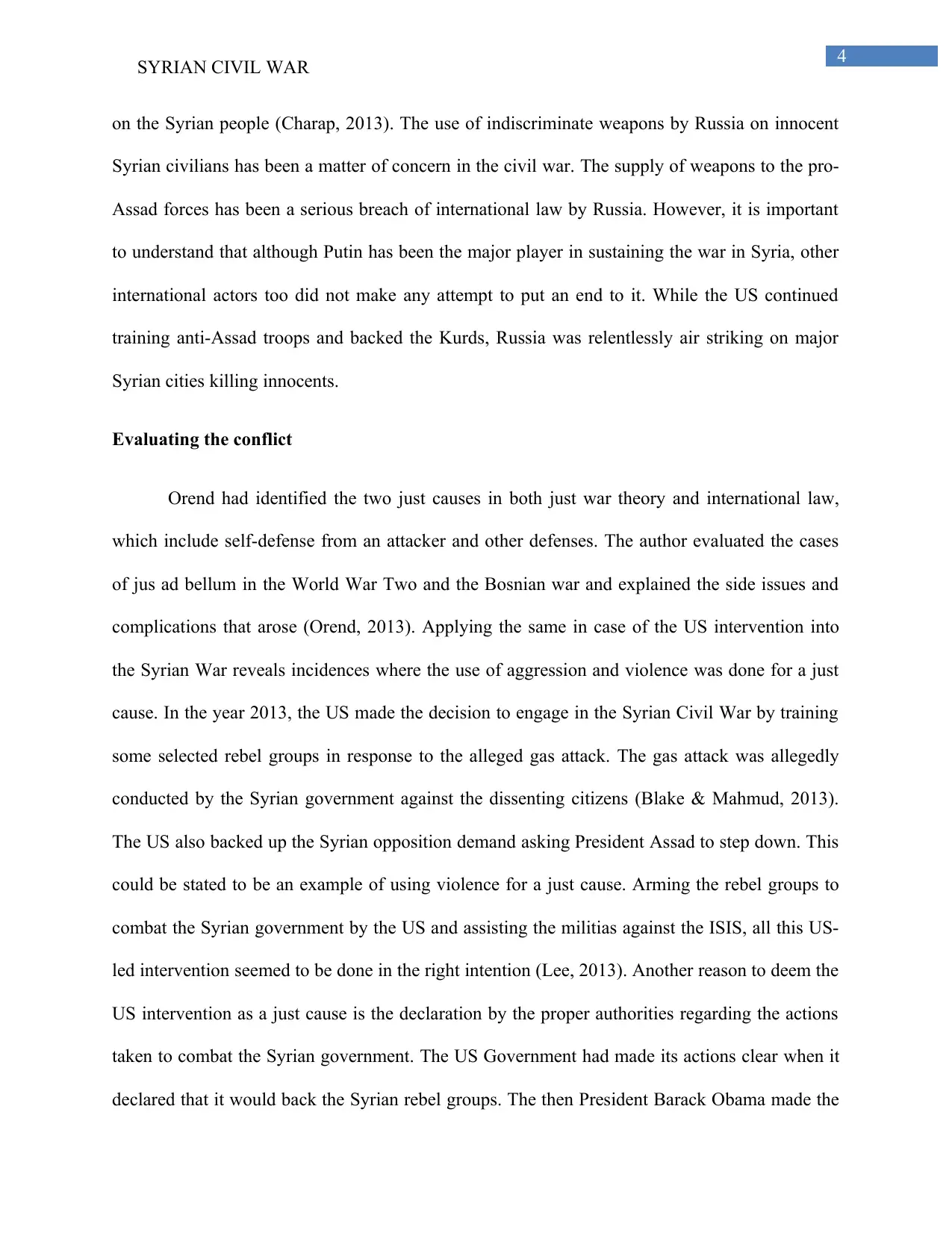
4
SYRIAN CIVIL WAR
on the Syrian people (Charap, 2013). The use of indiscriminate weapons by Russia on innocent
Syrian civilians has been a matter of concern in the civil war. The supply of weapons to the pro-
Assad forces has been a serious breach of international law by Russia. However, it is important
to understand that although Putin has been the major player in sustaining the war in Syria, other
international actors too did not make any attempt to put an end to it. While the US continued
training anti-Assad troops and backed the Kurds, Russia was relentlessly air striking on major
Syrian cities killing innocents.
Evaluating the conflict
Orend had identified the two just causes in both just war theory and international law,
which include self-defense from an attacker and other defenses. The author evaluated the cases
of jus ad bellum in the World War Two and the Bosnian war and explained the side issues and
complications that arose (Orend, 2013). Applying the same in case of the US intervention into
the Syrian War reveals incidences where the use of aggression and violence was done for a just
cause. In the year 2013, the US made the decision to engage in the Syrian Civil War by training
some selected rebel groups in response to the alleged gas attack. The gas attack was allegedly
conducted by the Syrian government against the dissenting citizens (Blake & Mahmud, 2013).
The US also backed up the Syrian opposition demand asking President Assad to step down. This
could be stated to be an example of using violence for a just cause. Arming the rebel groups to
combat the Syrian government by the US and assisting the militias against the ISIS, all this US-
led intervention seemed to be done in the right intention (Lee, 2013). Another reason to deem the
US intervention as a just cause is the declaration by the proper authorities regarding the actions
taken to combat the Syrian government. The US Government had made its actions clear when it
declared that it would back the Syrian rebel groups. The then President Barack Obama made the
SYRIAN CIVIL WAR
on the Syrian people (Charap, 2013). The use of indiscriminate weapons by Russia on innocent
Syrian civilians has been a matter of concern in the civil war. The supply of weapons to the pro-
Assad forces has been a serious breach of international law by Russia. However, it is important
to understand that although Putin has been the major player in sustaining the war in Syria, other
international actors too did not make any attempt to put an end to it. While the US continued
training anti-Assad troops and backed the Kurds, Russia was relentlessly air striking on major
Syrian cities killing innocents.
Evaluating the conflict
Orend had identified the two just causes in both just war theory and international law,
which include self-defense from an attacker and other defenses. The author evaluated the cases
of jus ad bellum in the World War Two and the Bosnian war and explained the side issues and
complications that arose (Orend, 2013). Applying the same in case of the US intervention into
the Syrian War reveals incidences where the use of aggression and violence was done for a just
cause. In the year 2013, the US made the decision to engage in the Syrian Civil War by training
some selected rebel groups in response to the alleged gas attack. The gas attack was allegedly
conducted by the Syrian government against the dissenting citizens (Blake & Mahmud, 2013).
The US also backed up the Syrian opposition demand asking President Assad to step down. This
could be stated to be an example of using violence for a just cause. Arming the rebel groups to
combat the Syrian government by the US and assisting the militias against the ISIS, all this US-
led intervention seemed to be done in the right intention (Lee, 2013). Another reason to deem the
US intervention as a just cause is the declaration by the proper authorities regarding the actions
taken to combat the Syrian government. The US Government had made its actions clear when it
declared that it would back the Syrian rebel groups. The then President Barack Obama made the
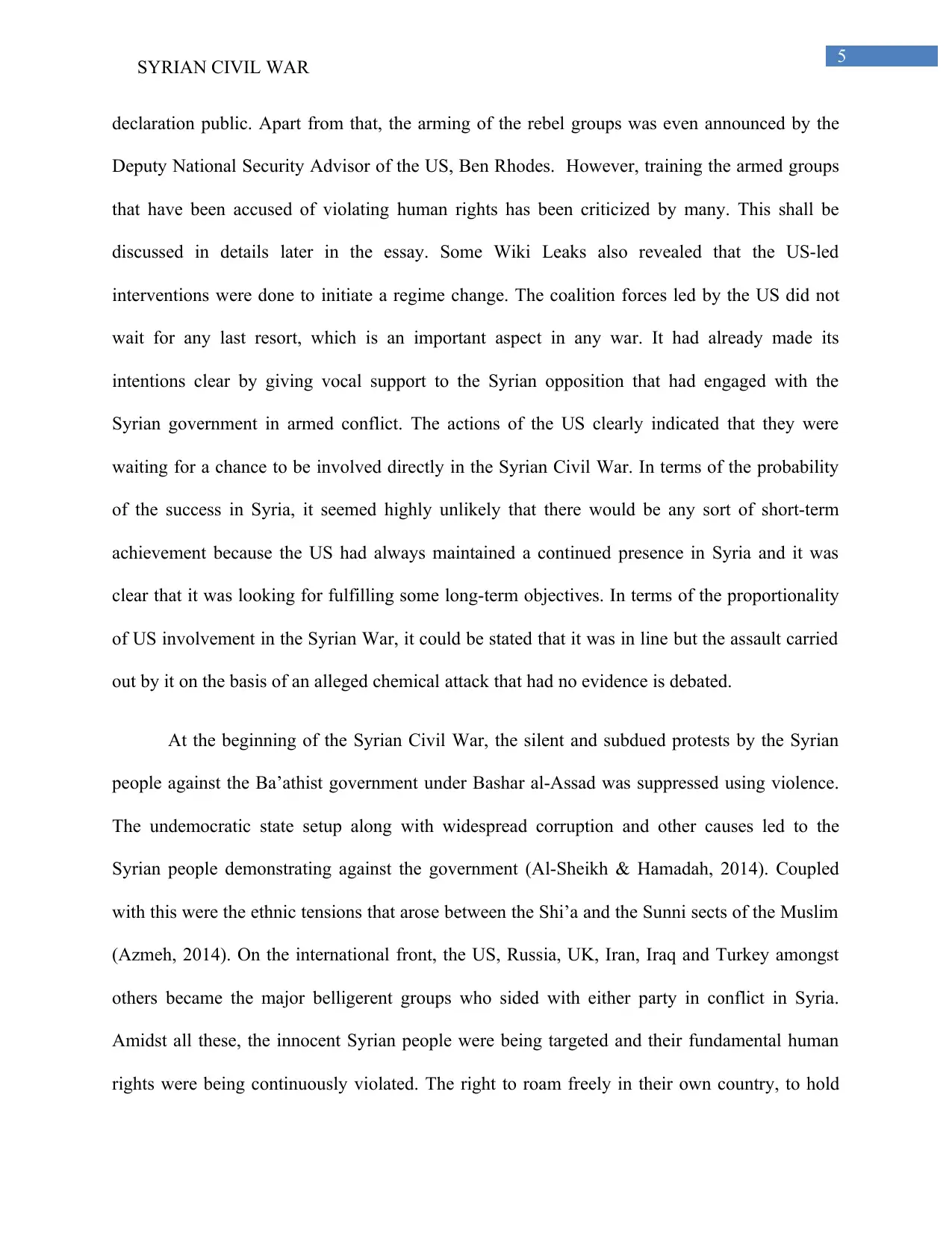
5
SYRIAN CIVIL WAR
declaration public. Apart from that, the arming of the rebel groups was even announced by the
Deputy National Security Advisor of the US, Ben Rhodes. However, training the armed groups
that have been accused of violating human rights has been criticized by many. This shall be
discussed in details later in the essay. Some Wiki Leaks also revealed that the US-led
interventions were done to initiate a regime change. The coalition forces led by the US did not
wait for any last resort, which is an important aspect in any war. It had already made its
intentions clear by giving vocal support to the Syrian opposition that had engaged with the
Syrian government in armed conflict. The actions of the US clearly indicated that they were
waiting for a chance to be involved directly in the Syrian Civil War. In terms of the probability
of the success in Syria, it seemed highly unlikely that there would be any sort of short-term
achievement because the US had always maintained a continued presence in Syria and it was
clear that it was looking for fulfilling some long-term objectives. In terms of the proportionality
of US involvement in the Syrian War, it could be stated that it was in line but the assault carried
out by it on the basis of an alleged chemical attack that had no evidence is debated.
At the beginning of the Syrian Civil War, the silent and subdued protests by the Syrian
people against the Ba’athist government under Bashar al-Assad was suppressed using violence.
The undemocratic state setup along with widespread corruption and other causes led to the
Syrian people demonstrating against the government (Al-Sheikh & Hamadah, 2014). Coupled
with this were the ethnic tensions that arose between the Shi’a and the Sunni sects of the Muslim
(Azmeh, 2014). On the international front, the US, Russia, UK, Iran, Iraq and Turkey amongst
others became the major belligerent groups who sided with either party in conflict in Syria.
Amidst all these, the innocent Syrian people were being targeted and their fundamental human
rights were being continuously violated. The right to roam freely in their own country, to hold
SYRIAN CIVIL WAR
declaration public. Apart from that, the arming of the rebel groups was even announced by the
Deputy National Security Advisor of the US, Ben Rhodes. However, training the armed groups
that have been accused of violating human rights has been criticized by many. This shall be
discussed in details later in the essay. Some Wiki Leaks also revealed that the US-led
interventions were done to initiate a regime change. The coalition forces led by the US did not
wait for any last resort, which is an important aspect in any war. It had already made its
intentions clear by giving vocal support to the Syrian opposition that had engaged with the
Syrian government in armed conflict. The actions of the US clearly indicated that they were
waiting for a chance to be involved directly in the Syrian Civil War. In terms of the probability
of the success in Syria, it seemed highly unlikely that there would be any sort of short-term
achievement because the US had always maintained a continued presence in Syria and it was
clear that it was looking for fulfilling some long-term objectives. In terms of the proportionality
of US involvement in the Syrian War, it could be stated that it was in line but the assault carried
out by it on the basis of an alleged chemical attack that had no evidence is debated.
At the beginning of the Syrian Civil War, the silent and subdued protests by the Syrian
people against the Ba’athist government under Bashar al-Assad was suppressed using violence.
The undemocratic state setup along with widespread corruption and other causes led to the
Syrian people demonstrating against the government (Al-Sheikh & Hamadah, 2014). Coupled
with this were the ethnic tensions that arose between the Shi’a and the Sunni sects of the Muslim
(Azmeh, 2014). On the international front, the US, Russia, UK, Iran, Iraq and Turkey amongst
others became the major belligerent groups who sided with either party in conflict in Syria.
Amidst all these, the innocent Syrian people were being targeted and their fundamental human
rights were being continuously violated. The right to roam freely in their own country, to hold
⊘ This is a preview!⊘
Do you want full access?
Subscribe today to unlock all pages.

Trusted by 1+ million students worldwide
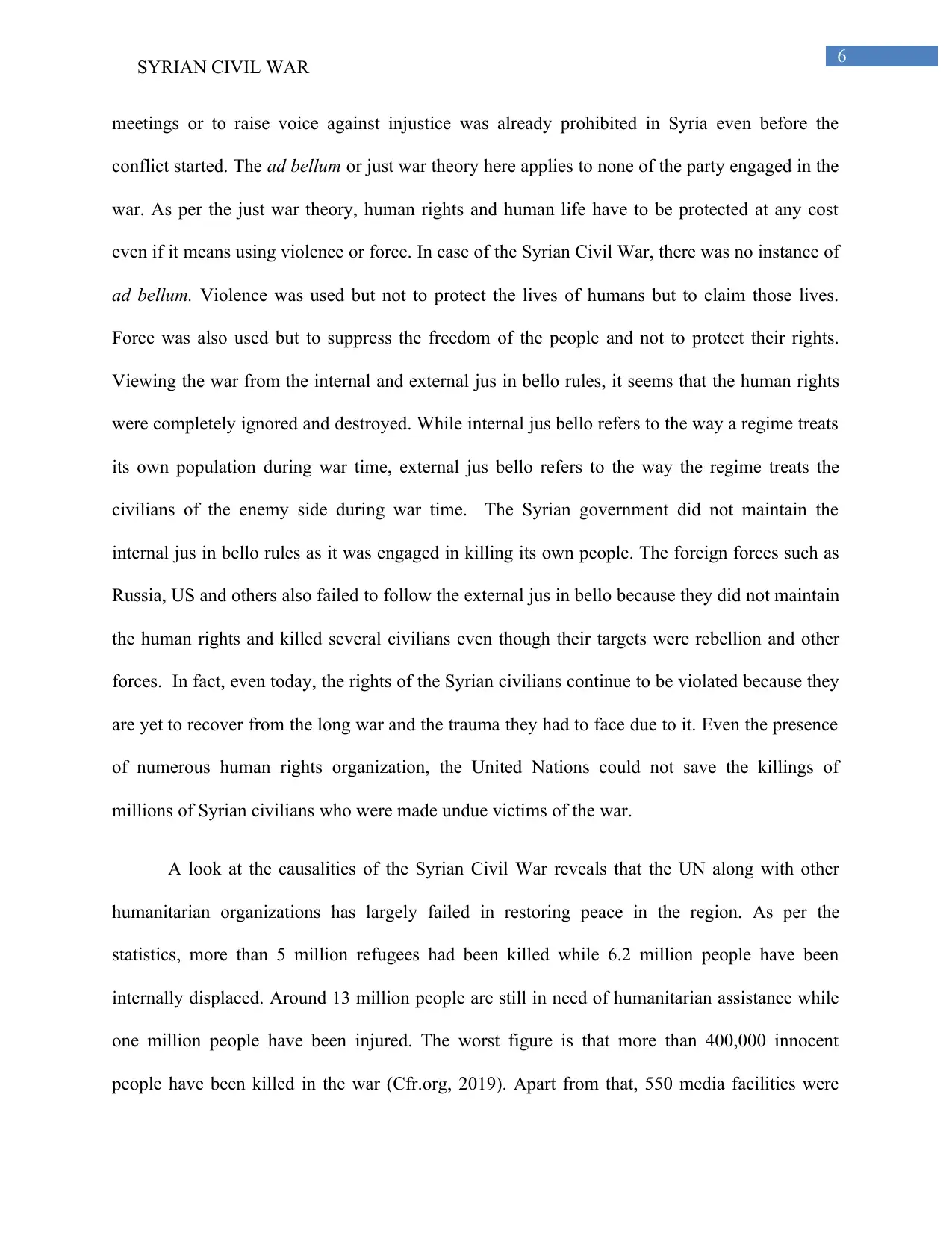
6
SYRIAN CIVIL WAR
meetings or to raise voice against injustice was already prohibited in Syria even before the
conflict started. The ad bellum or just war theory here applies to none of the party engaged in the
war. As per the just war theory, human rights and human life have to be protected at any cost
even if it means using violence or force. In case of the Syrian Civil War, there was no instance of
ad bellum. Violence was used but not to protect the lives of humans but to claim those lives.
Force was also used but to suppress the freedom of the people and not to protect their rights.
Viewing the war from the internal and external jus in bello rules, it seems that the human rights
were completely ignored and destroyed. While internal jus bello refers to the way a regime treats
its own population during war time, external jus bello refers to the way the regime treats the
civilians of the enemy side during war time. The Syrian government did not maintain the
internal jus in bello rules as it was engaged in killing its own people. The foreign forces such as
Russia, US and others also failed to follow the external jus in bello because they did not maintain
the human rights and killed several civilians even though their targets were rebellion and other
forces. In fact, even today, the rights of the Syrian civilians continue to be violated because they
are yet to recover from the long war and the trauma they had to face due to it. Even the presence
of numerous human rights organization, the United Nations could not save the killings of
millions of Syrian civilians who were made undue victims of the war.
A look at the causalities of the Syrian Civil War reveals that the UN along with other
humanitarian organizations has largely failed in restoring peace in the region. As per the
statistics, more than 5 million refugees had been killed while 6.2 million people have been
internally displaced. Around 13 million people are still in need of humanitarian assistance while
one million people have been injured. The worst figure is that more than 400,000 innocent
people have been killed in the war (Cfr.org, 2019). Apart from that, 550 media facilities were
SYRIAN CIVIL WAR
meetings or to raise voice against injustice was already prohibited in Syria even before the
conflict started. The ad bellum or just war theory here applies to none of the party engaged in the
war. As per the just war theory, human rights and human life have to be protected at any cost
even if it means using violence or force. In case of the Syrian Civil War, there was no instance of
ad bellum. Violence was used but not to protect the lives of humans but to claim those lives.
Force was also used but to suppress the freedom of the people and not to protect their rights.
Viewing the war from the internal and external jus in bello rules, it seems that the human rights
were completely ignored and destroyed. While internal jus bello refers to the way a regime treats
its own population during war time, external jus bello refers to the way the regime treats the
civilians of the enemy side during war time. The Syrian government did not maintain the
internal jus in bello rules as it was engaged in killing its own people. The foreign forces such as
Russia, US and others also failed to follow the external jus in bello because they did not maintain
the human rights and killed several civilians even though their targets were rebellion and other
forces. In fact, even today, the rights of the Syrian civilians continue to be violated because they
are yet to recover from the long war and the trauma they had to face due to it. Even the presence
of numerous human rights organization, the United Nations could not save the killings of
millions of Syrian civilians who were made undue victims of the war.
A look at the causalities of the Syrian Civil War reveals that the UN along with other
humanitarian organizations has largely failed in restoring peace in the region. As per the
statistics, more than 5 million refugees had been killed while 6.2 million people have been
internally displaced. Around 13 million people are still in need of humanitarian assistance while
one million people have been injured. The worst figure is that more than 400,000 innocent
people have been killed in the war (Cfr.org, 2019). Apart from that, 550 media facilities were
Paraphrase This Document
Need a fresh take? Get an instant paraphrase of this document with our AI Paraphraser
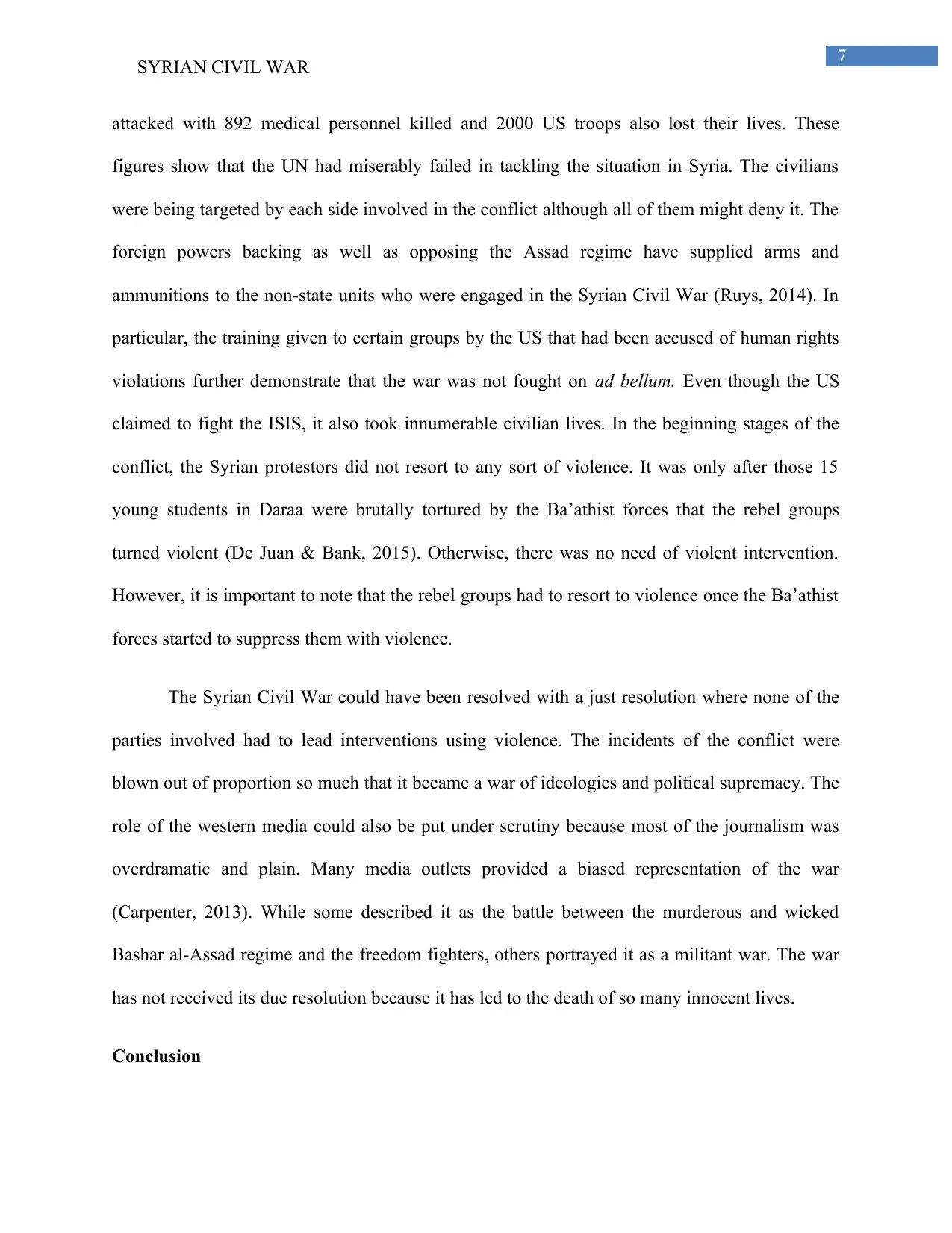
7
SYRIAN CIVIL WAR
attacked with 892 medical personnel killed and 2000 US troops also lost their lives. These
figures show that the UN had miserably failed in tackling the situation in Syria. The civilians
were being targeted by each side involved in the conflict although all of them might deny it. The
foreign powers backing as well as opposing the Assad regime have supplied arms and
ammunitions to the non-state units who were engaged in the Syrian Civil War (Ruys, 2014). In
particular, the training given to certain groups by the US that had been accused of human rights
violations further demonstrate that the war was not fought on ad bellum. Even though the US
claimed to fight the ISIS, it also took innumerable civilian lives. In the beginning stages of the
conflict, the Syrian protestors did not resort to any sort of violence. It was only after those 15
young students in Daraa were brutally tortured by the Ba’athist forces that the rebel groups
turned violent (De Juan & Bank, 2015). Otherwise, there was no need of violent intervention.
However, it is important to note that the rebel groups had to resort to violence once the Ba’athist
forces started to suppress them with violence.
The Syrian Civil War could have been resolved with a just resolution where none of the
parties involved had to lead interventions using violence. The incidents of the conflict were
blown out of proportion so much that it became a war of ideologies and political supremacy. The
role of the western media could also be put under scrutiny because most of the journalism was
overdramatic and plain. Many media outlets provided a biased representation of the war
(Carpenter, 2013). While some described it as the battle between the murderous and wicked
Bashar al-Assad regime and the freedom fighters, others portrayed it as a militant war. The war
has not received its due resolution because it has led to the death of so many innocent lives.
Conclusion
SYRIAN CIVIL WAR
attacked with 892 medical personnel killed and 2000 US troops also lost their lives. These
figures show that the UN had miserably failed in tackling the situation in Syria. The civilians
were being targeted by each side involved in the conflict although all of them might deny it. The
foreign powers backing as well as opposing the Assad regime have supplied arms and
ammunitions to the non-state units who were engaged in the Syrian Civil War (Ruys, 2014). In
particular, the training given to certain groups by the US that had been accused of human rights
violations further demonstrate that the war was not fought on ad bellum. Even though the US
claimed to fight the ISIS, it also took innumerable civilian lives. In the beginning stages of the
conflict, the Syrian protestors did not resort to any sort of violence. It was only after those 15
young students in Daraa were brutally tortured by the Ba’athist forces that the rebel groups
turned violent (De Juan & Bank, 2015). Otherwise, there was no need of violent intervention.
However, it is important to note that the rebel groups had to resort to violence once the Ba’athist
forces started to suppress them with violence.
The Syrian Civil War could have been resolved with a just resolution where none of the
parties involved had to lead interventions using violence. The incidents of the conflict were
blown out of proportion so much that it became a war of ideologies and political supremacy. The
role of the western media could also be put under scrutiny because most of the journalism was
overdramatic and plain. Many media outlets provided a biased representation of the war
(Carpenter, 2013). While some described it as the battle between the murderous and wicked
Bashar al-Assad regime and the freedom fighters, others portrayed it as a militant war. The war
has not received its due resolution because it has led to the death of so many innocent lives.
Conclusion
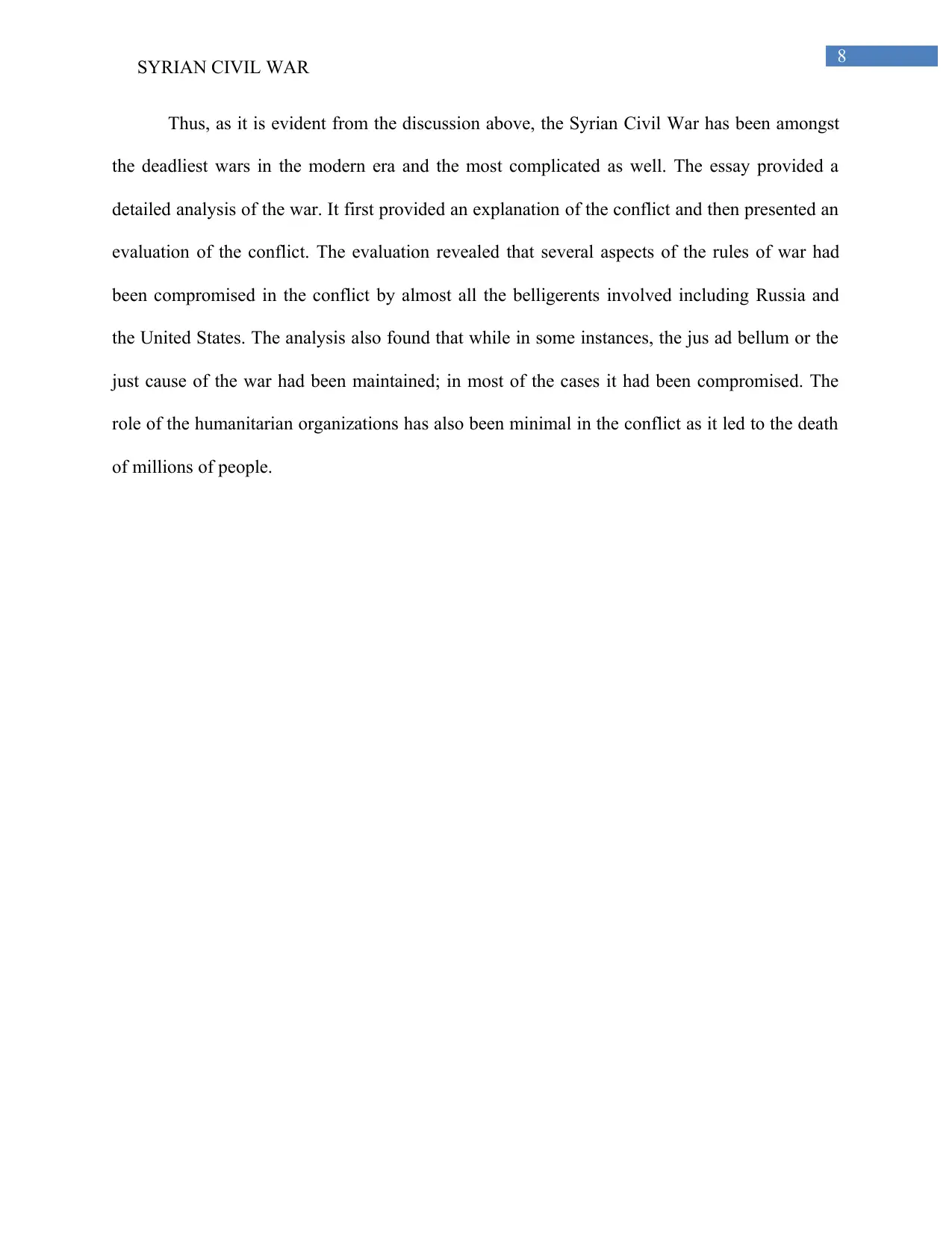
8
SYRIAN CIVIL WAR
Thus, as it is evident from the discussion above, the Syrian Civil War has been amongst
the deadliest wars in the modern era and the most complicated as well. The essay provided a
detailed analysis of the war. It first provided an explanation of the conflict and then presented an
evaluation of the conflict. The evaluation revealed that several aspects of the rules of war had
been compromised in the conflict by almost all the belligerents involved including Russia and
the United States. The analysis also found that while in some instances, the jus ad bellum or the
just cause of the war had been maintained; in most of the cases it had been compromised. The
role of the humanitarian organizations has also been minimal in the conflict as it led to the death
of millions of people.
SYRIAN CIVIL WAR
Thus, as it is evident from the discussion above, the Syrian Civil War has been amongst
the deadliest wars in the modern era and the most complicated as well. The essay provided a
detailed analysis of the war. It first provided an explanation of the conflict and then presented an
evaluation of the conflict. The evaluation revealed that several aspects of the rules of war had
been compromised in the conflict by almost all the belligerents involved including Russia and
the United States. The analysis also found that while in some instances, the jus ad bellum or the
just cause of the war had been maintained; in most of the cases it had been compromised. The
role of the humanitarian organizations has also been minimal in the conflict as it led to the death
of millions of people.
⊘ This is a preview!⊘
Do you want full access?
Subscribe today to unlock all pages.

Trusted by 1+ million students worldwide
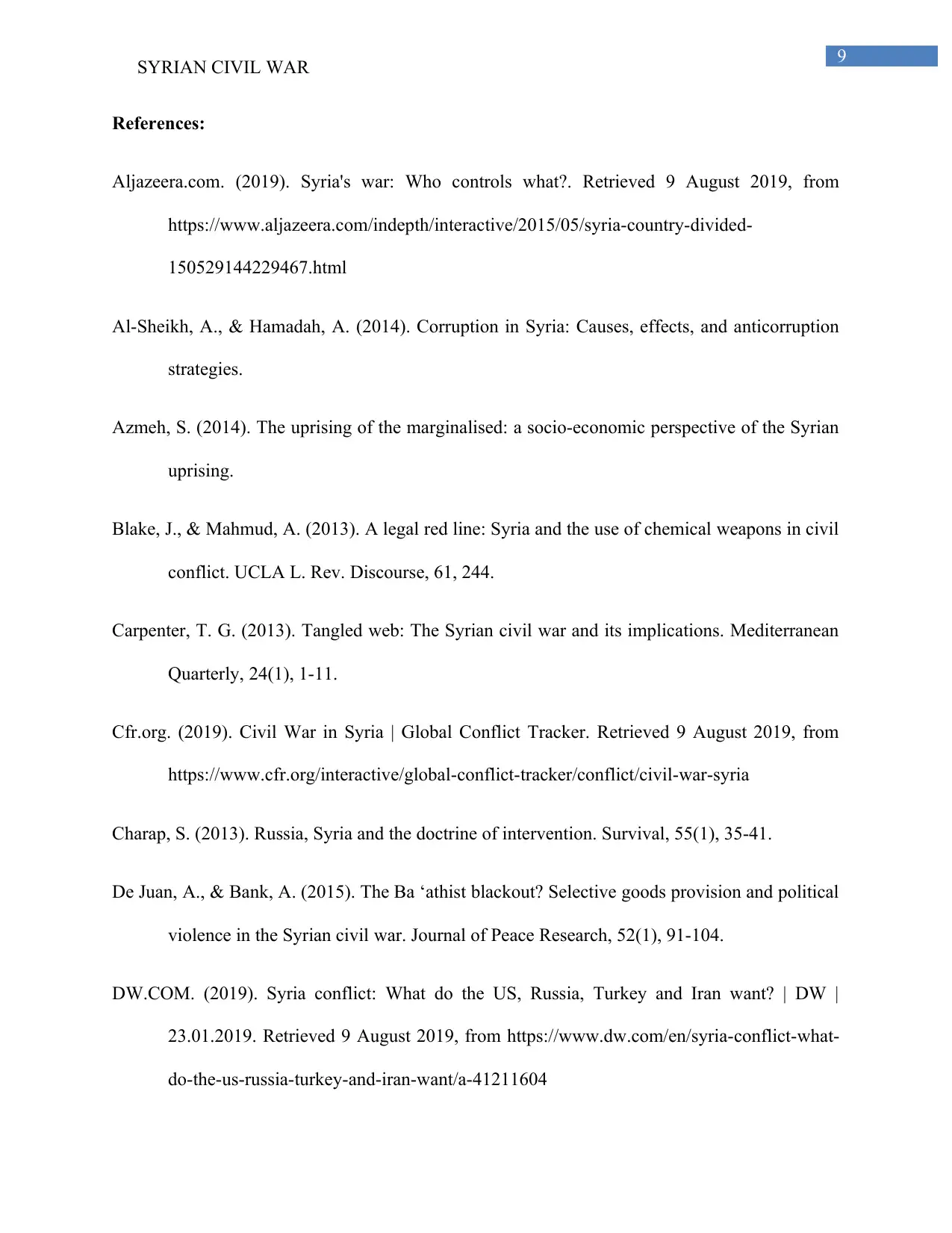
9
SYRIAN CIVIL WAR
References:
Aljazeera.com. (2019). Syria's war: Who controls what?. Retrieved 9 August 2019, from
https://www.aljazeera.com/indepth/interactive/2015/05/syria-country-divided-
150529144229467.html
Al-Sheikh, A., & Hamadah, A. (2014). Corruption in Syria: Causes, effects, and anticorruption
strategies.
Azmeh, S. (2014). The uprising of the marginalised: a socio-economic perspective of the Syrian
uprising.
Blake, J., & Mahmud, A. (2013). A legal red line: Syria and the use of chemical weapons in civil
conflict. UCLA L. Rev. Discourse, 61, 244.
Carpenter, T. G. (2013). Tangled web: The Syrian civil war and its implications. Mediterranean
Quarterly, 24(1), 1-11.
Cfr.org. (2019). Civil War in Syria | Global Conflict Tracker. Retrieved 9 August 2019, from
https://www.cfr.org/interactive/global-conflict-tracker/conflict/civil-war-syria
Charap, S. (2013). Russia, Syria and the doctrine of intervention. Survival, 55(1), 35-41.
De Juan, A., & Bank, A. (2015). The Ba ‘athist blackout? Selective goods provision and political
violence in the Syrian civil war. Journal of Peace Research, 52(1), 91-104.
DW.COM. (2019). Syria conflict: What do the US, Russia, Turkey and Iran want? | DW |
23.01.2019. Retrieved 9 August 2019, from https://www.dw.com/en/syria-conflict-what-
do-the-us-russia-turkey-and-iran-want/a-41211604
SYRIAN CIVIL WAR
References:
Aljazeera.com. (2019). Syria's war: Who controls what?. Retrieved 9 August 2019, from
https://www.aljazeera.com/indepth/interactive/2015/05/syria-country-divided-
150529144229467.html
Al-Sheikh, A., & Hamadah, A. (2014). Corruption in Syria: Causes, effects, and anticorruption
strategies.
Azmeh, S. (2014). The uprising of the marginalised: a socio-economic perspective of the Syrian
uprising.
Blake, J., & Mahmud, A. (2013). A legal red line: Syria and the use of chemical weapons in civil
conflict. UCLA L. Rev. Discourse, 61, 244.
Carpenter, T. G. (2013). Tangled web: The Syrian civil war and its implications. Mediterranean
Quarterly, 24(1), 1-11.
Cfr.org. (2019). Civil War in Syria | Global Conflict Tracker. Retrieved 9 August 2019, from
https://www.cfr.org/interactive/global-conflict-tracker/conflict/civil-war-syria
Charap, S. (2013). Russia, Syria and the doctrine of intervention. Survival, 55(1), 35-41.
De Juan, A., & Bank, A. (2015). The Ba ‘athist blackout? Selective goods provision and political
violence in the Syrian civil war. Journal of Peace Research, 52(1), 91-104.
DW.COM. (2019). Syria conflict: What do the US, Russia, Turkey and Iran want? | DW |
23.01.2019. Retrieved 9 August 2019, from https://www.dw.com/en/syria-conflict-what-
do-the-us-russia-turkey-and-iran-want/a-41211604
Paraphrase This Document
Need a fresh take? Get an instant paraphrase of this document with our AI Paraphraser
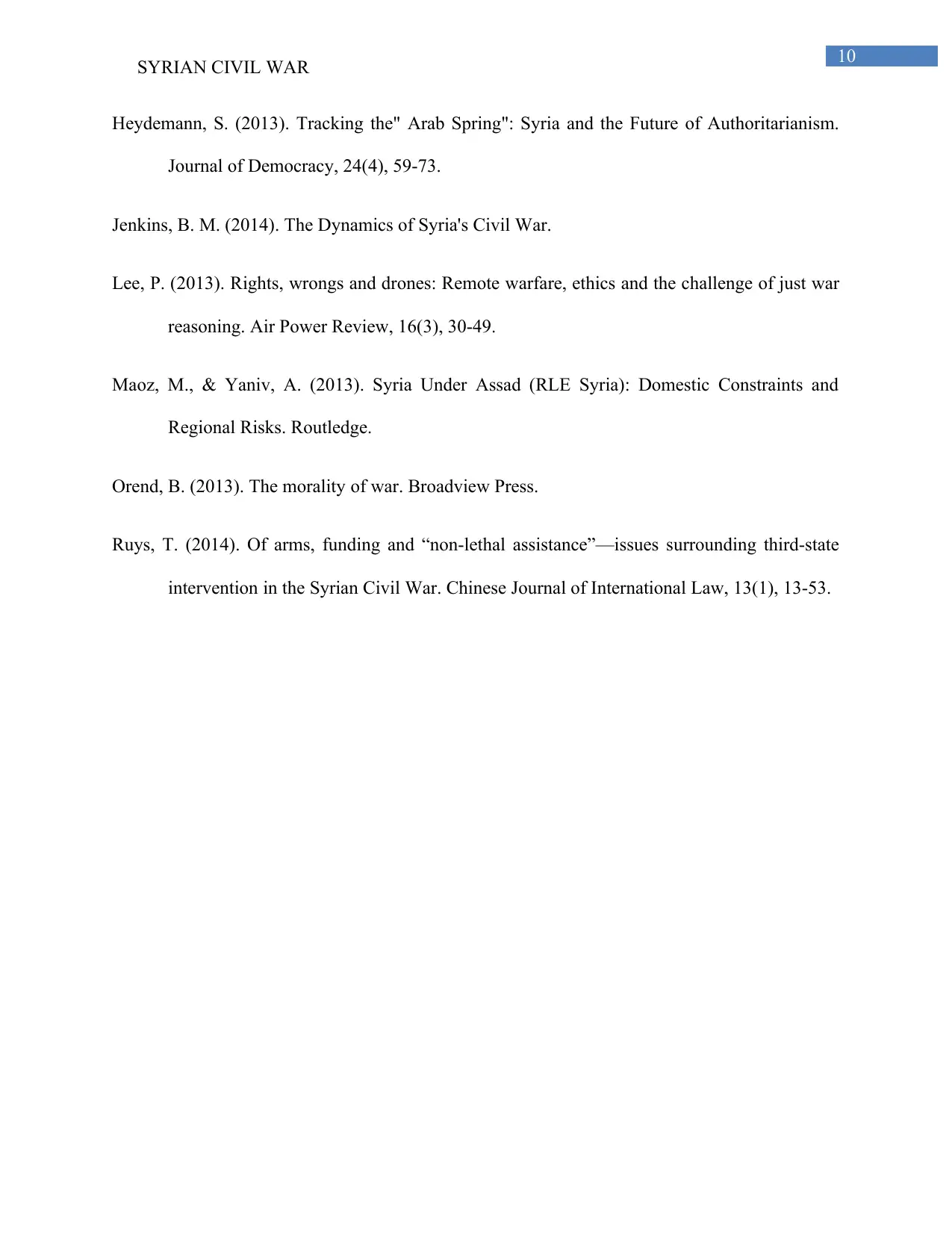
10
SYRIAN CIVIL WAR
Heydemann, S. (2013). Tracking the" Arab Spring": Syria and the Future of Authoritarianism.
Journal of Democracy, 24(4), 59-73.
Jenkins, B. M. (2014). The Dynamics of Syria's Civil War.
Lee, P. (2013). Rights, wrongs and drones: Remote warfare, ethics and the challenge of just war
reasoning. Air Power Review, 16(3), 30-49.
Maoz, M., & Yaniv, A. (2013). Syria Under Assad (RLE Syria): Domestic Constraints and
Regional Risks. Routledge.
Orend, B. (2013). The morality of war. Broadview Press.
Ruys, T. (2014). Of arms, funding and “non-lethal assistance”—issues surrounding third-state
intervention in the Syrian Civil War. Chinese Journal of International Law, 13(1), 13-53.
SYRIAN CIVIL WAR
Heydemann, S. (2013). Tracking the" Arab Spring": Syria and the Future of Authoritarianism.
Journal of Democracy, 24(4), 59-73.
Jenkins, B. M. (2014). The Dynamics of Syria's Civil War.
Lee, P. (2013). Rights, wrongs and drones: Remote warfare, ethics and the challenge of just war
reasoning. Air Power Review, 16(3), 30-49.
Maoz, M., & Yaniv, A. (2013). Syria Under Assad (RLE Syria): Domestic Constraints and
Regional Risks. Routledge.
Orend, B. (2013). The morality of war. Broadview Press.
Ruys, T. (2014). Of arms, funding and “non-lethal assistance”—issues surrounding third-state
intervention in the Syrian Civil War. Chinese Journal of International Law, 13(1), 13-53.
1 out of 11
Related Documents
Your All-in-One AI-Powered Toolkit for Academic Success.
+13062052269
info@desklib.com
Available 24*7 on WhatsApp / Email
![[object Object]](/_next/static/media/star-bottom.7253800d.svg)
Unlock your academic potential
Copyright © 2020–2025 A2Z Services. All Rights Reserved. Developed and managed by ZUCOL.



